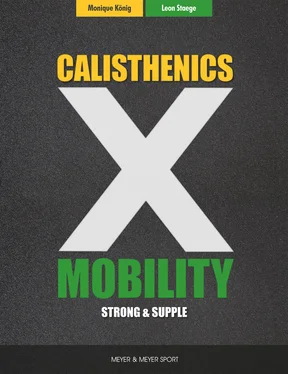While applying this mentality to mobility is a big mistake, many do exactly that: If you want to have bulging biceps, do a lot of curls. If you want strong legs for doing squats, do a lot of squats. If you want to be able to do more pull-ups, do a lot of pull-ups. But do you want to get “better” at pain? Probably not. Our bodies never stop learning. They adapt and remodel themselves as needed. You should therefore provoke pain as little as possible.
Moving pain-free applies to the healthy athlete as well as the injured one. Irritating your body with constant pain impulses isn’t beneficial to training or rehabilitation.
When you lie down on the foam roller, it can be unpleasant, but it shouldn’t end with a flood of crocodile tears. Pain-free moving is healthy moving. You can find more information in section 3.2, “Pain and Injuries.”
2.5.5 FOAM ROLLERS—SENSE OR NONSENSE?
At this point, you’re likely asking yourself if the foam roller is a complete waste of time.
Or if you should use it now and then.

Remember this:
The foam roller is a tool.
No more, no less. It’s not a panacea for tight muscles, sore muscles, or achieving a great, powerful range of motion. When you use it, check to see if it was beneficial (did your mobility improve?). And remember that moving is the best remedy.
Spend more time with your body (e.g., using mobility or calisthenics) than with any fitness gadgets.
You can learn how to test your movement ability in subsection 3.1.1, “Evaluation.”
2.6 MORE EXERCISE EQUIPMENT YOU DON’T NEED
What’s true for foam rollers (i.e., they’re not equipment you necessarily need) is true for using gloves or a weightlifting belt during training.
At Calisthenics X Mobility workshops, people always ask Monique what she thinks about wearing gloves during calisthenics training. And, similarly, they ask me with respect to weightlifting belts for deadlifts and squats.
The answer is similar to that of the foam roller. All these things are tools. You should know each tool’s specific use without depending on any of them. Using gloves during calisthenics training is very popular because gripping the bars causes callouses to form on the hands. In many circles, callouses are considered unaesthetic. Moreover, some look to the example of gymnasts who wear wrist supports so they can swing around the horizontal bar.
If we take a quick look back at human history, it becomes apparent why calloused hands are considered unattractive. In the past, there were working peasants and the nobility. Unlike the working peasants, the nobility didn’t have callouses on their hands, because the nobles didn’t do hard work. Back then, unblemished skin was considered a beauty ideal.
To reemphasize, if you aren’t a world-class athlete, there are no technical, performance reasons for using gloves or a weightlifting belt during legwork, only aesthetics. At best, these tools will lower your performance. After all, humans are creatures of habit. You’ll quickly rely on the supposed protection, which can cause the quality of your movements to suffer.
Gloves don’t allow you to grip the bar properly, and a belt won’t let you maintain proper abdominal tension. This advice applies particularly to beginners and slightly advanced athletes who have maybe one to three years of training experience. All others, if they’ve completed the proper training, have learned how to control their bodies for a certain movement, which is why these tools can certainly be useful. It’s all a matter of performance level and the way you use these things.
2.7 HOW MOBILITY MAKES YOU STRONGER
If you’ve read up to this point, you already know more about modern mobility training than 90 percent of athletes. But aside from all the useful facts about mobility and movement overall, you’re probably asking yourself why this book about mobility is so detailed. Why not, like most strength-training books, describe 10 simple exercises, half of which should ideally be performed with a foam roller, and then sell it as “mobility training”? Mobility is far more than a little warm-up or cool-down. Mobility is the prerequisite for maximum strength development. Here, we can refer to the laws of physics:

strength = mass × acceleration (m/s 2)
With respect to calisthenics, it’s quite simple because the mass to be accelerated is your own bodyweight. Now we have two factors that can influence our strength with respect to our bodyweight. For instance, for a pull-up, we can change the distance or the time with which we accelerate upward.
I like to simplify things, so simply put, the more distance (feet or meters) I have at my disposal, the greater the resulting strength potential. Even simpler, mobility has an immediate effect on your strength. But there are additional factors that emphasize the importance of mobility training.
There are frequent debates about the extent to which mobility training tested in this manner has a positive effect on regeneration and injury prevention.
To date, the consensus seems to be that we’re not really sure or that occasionally negative results have been ascertained with respect to prevention and regeneration.
I don’t wish to engage in an emotionally charged scientific debate on whether the studies are reliable and convincing, but I want to take a more sober approach. In this book, I want to present the arguments in a simpler way than referring to meta-analyses.
Mobility will give you control over your joints. In gaining control, you’ll place your joints at all their various angles and give your body what it really needs: variation.
I’ll continue to revisit this point throughout this book. After all, variety is what preserves our joints when we keep performing repetitive motions in sports.
So you’ll become more resilient against unfamiliar movements and joint positions and will thus reduce the severity of any potential injuries.
2.8 WHY STRESS MAKES YOU IMMOBILE
An often completely ignored aspect of mobility is the opportunity to self-analyze one’s performance capacity during training.
Imagine you had a stressful week and worked out only once.
And recently you’d frequently been more stressed. Because you haven’t been able to work out regularly, you give 150 percent during your one weekly workout. On the days following, your muscles are correspondingly sore.
You’re experiencing multiple factors that are greatly increasing your likelihood of an injury: stress–possibly resulting in a lack of focus during training because you have too much on your mind–and irregular physical exercise). Hence it’s extremely important that you’re able to assess your performance capacity before a workout. During these pre-workout assessments, you’ll definitely feel less mobile. Mobility exercises are even less fun, which can result in a false interpretation of their effectiveness.
Many of my clients have had the problem of doing even fewer mobility exercises during stressful times, when they should have been doing more. They thought mobility just wasn’t their thing and were frustrated when they regressed. And yet the cause was merely the fact that their current stress levels were too high. Maybe you’ve felt the same way and skipped your mobility training.
Читать дальше














